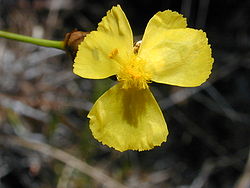| Xyris | |
|---|---|
 | |
| Xyris complanata | |
| Scientific classification | |
| Kingdom: | Plantae |
| Clade: | Tracheophytes |
| Clade: | Angiosperms |
| Clade: | Monocots |
| Clade: | Commelinids |
| Order: | Poales |
| Family: | Xyridaceae |
| Genus: | Xyris L. [1] |
| Synonyms [2] | |
| |
Xyris is a genus of flowering plants, the yelloweyed grasses, in the yellow-eyed-grass family. The genus counts over 250 species, widespread over much of the world, with the center of distribution in the Guianas. [2] [3] [4]
The leaves are mostly distichous, linear, flat, and thin or round with a conspicuous sheath at the base. They are arranged in a basal aggregation. The small, yellow flowers are borne on a spherical or cylindrical spike or head (inflorescence). Each flower grows from the axil of a leathery bract. The fruit is a nonfleshy, dehiscent capsule. In Xyris complanata, a single flower bud on the spike appears in the morning, and expands into a conspicuous flower during the afternoon. [3]
The APG IV system, of 2016, places the genus in family Xyridaceae, into the order Poales in the clade commelinids, in the monocots.
- Xyris ambigua Beyrich ex Kunth
- Xyris andina Malme
- Xyris arenicola
- Xyris asperula
- Xyris baldwiniana Schultes
- Xyris bayardii
- Xyris brevifolia Michaux
- Xyris bulbosa
- Xyris caroliniana Walter
- Xyris chapmanii
- Xyris communis
- Xyris complanata R.Br.
- Xyris decipiens N.E.Br.
- Xyris difformis Chapman
- Xyris drummondii Malme
- Xyris elliottii Chapman
- Xyris elongata Rudge
- Xyris exilis Doust & B.J.Conn
- Xyris fimbriata Elliott
- Xyris flabelliformis Chapman
- Xyris flexifolia R.Br.
- Xyris flexuosa
- Xyris floridana
- Xyris gracilis R.Br.
- Xyris gracillima F.Muell.
- Xyris inaequalis N.A.Wakef.
- Xyris indica L.
- Xyris indivisa N.A.Wakef.
- Xyris iridifolia
- Xyris isoetifolia Kral,
- Xyris jupicai Richard
- Xyris juncea R.Br.
- Xyris lacera R.Br.
- Xyris lanata R.Br.
- Xyris laxiflora F.Muell.
- Xyris laxifolia Martius
- Xyris longisepala Kral
- Xyris louisianica
- Xyris macrocephala
- Xyris marginata Rendle
- Xyris montana Ries
- Xyris muelleri Malme
- Xyris neglecta
- Xyris operculata Labill.
- Xyris pallescens
- Xyris panacea
- Xyris papillosa
- Xyris paradisiaca
- Xyris pauciflora Willd.
- Xyris platylepis Chapman
- Xyris roycei N.A.Wakef.
- Xyris scabrifolia R. M. Harper
- Xyris serotina Chapman
- Xyris smalliana Nash
- Xyris stricta Chapman
- Xyris subalata
- Xyris tennesseensis Kral
- Xyris torta Smith
- Xyris ustulata L.A.Nilsson
